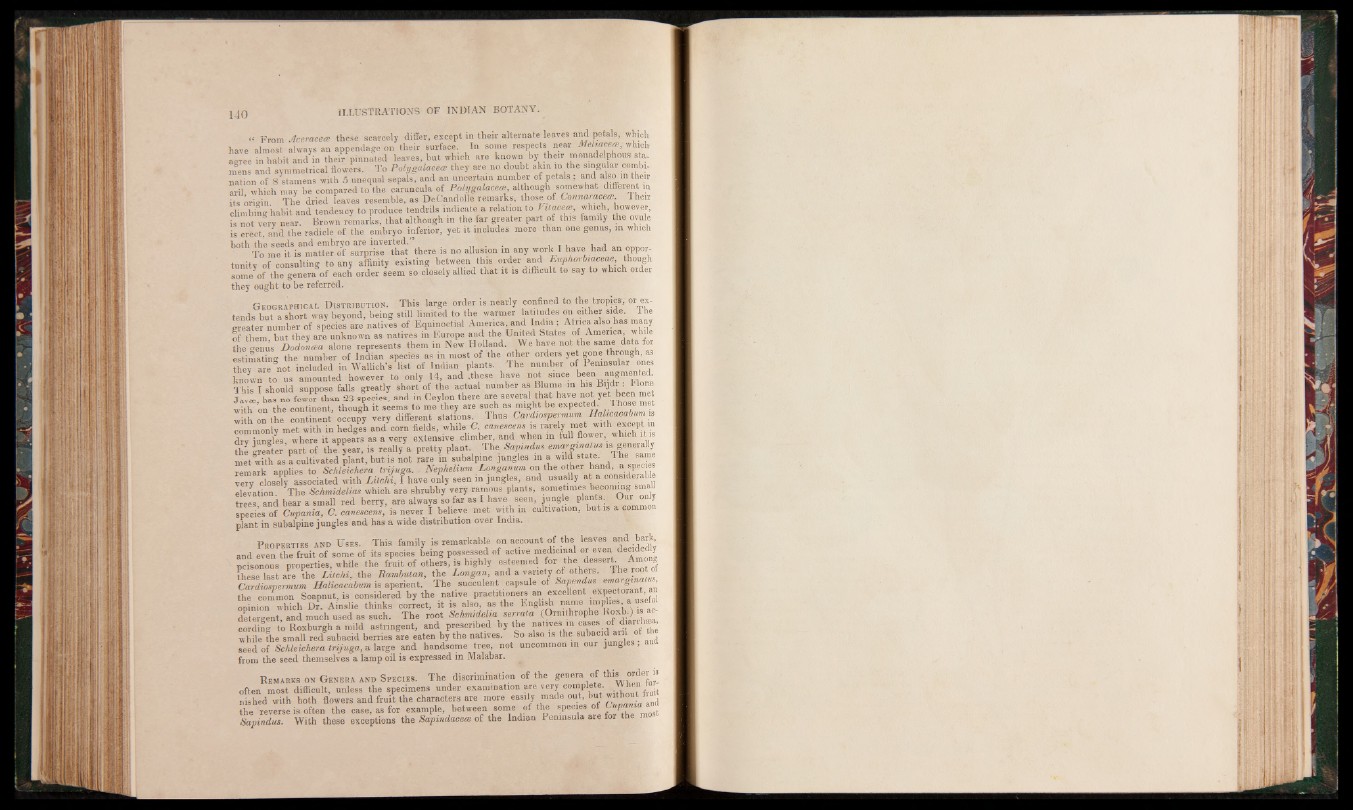
140 IL LUSTRATIONS OF IN D IA N BO T A N Y .
« From Aceracece these scarcely differ, except in their alternate leaves and petals, which
have almost always an appendage on their surface. In some respects near Melmcece, which
agree in habit and in their pinnated leaves, but which are known by their monadelphous s at
mens and symmetrical flowers. To Polygalaceat they are no doubt akin m the singular combi-
nation of 8 stamens with 5 unequal sepals, and an uncertain number of petals.; and also m their
aril which may be compared to the caruncula of P o ly g a la c e although somewhat different ,n
its origin The dried leaves resemble, as DeCandolle remarks, those of Connaracem. Their
climbing habit and tendency to produce tendrils indicate a relation to Vitacea, which, however,
iPs not very near. Brown remarks, that although in the far greater part of this family the ovule
is erfect, and the radicle of the embryo inferior, yet it includes more than one genus, in which
hoth the seeds and embryo are inverted.” . . T , ,
To me it is matter of surprise that there is no allusion in any work I have had an oppor-
tunity of consulting to any affinity existing between this order and Euphorbiaceae, though;
som e tfth e genera of each order seem so closely allied that it is difficult to say to which order |
they ought to be referred.
G eographical D istribution. This large order is nearly confined to the tropes, or extends
but a short way beyond, being still limited to the warmer latitudes on either side, lhe
greater number of species are natives of Equinoctial America and India; Africa also has many
of them but they are unknown as natives m Europe aud the United States of America while
the genus Dodoncea alone represents them in New Holland. We have not the same data for
estimating the number of Indian species as in most of the other orders yet gone through, as
they a.” not included in Wallich’s list of Indian plants. The number of Peninsular ones
known to us amounted however to only 14, and .these have not since been augmented.
This I should suppose falls greatly short of the actual number as Blume m his Brjdr : Flora
Java; has no fewer than 23 species, and in Ceylon there are several that have not yet been met
with on the continent, though it seems to me they are such as might be expected. Those met
whh on the continent occupy very different stations. Thus Cardwspermum Hahcacabum is
commonly met with in hedges and corn fields, while C. canescens is rarely met with eimept in
drv iungles where it appears as a very extensive climber, and when in full flower, which it is
the greater*part of the ?ear, is really a pretty plant The Sapindm
met with as a cultivated plant, but is not rare in subalpine jungles in a wild state. 1 he same
remark applies to Schleichera trijuga. Nephelium Longanum on the other hand, a species |
very closely associated with Litchi, I have only seen in jungles, and usually at a considerable
elevation The Schmidelias which are shrubby very ramous plants, sometimes becoming sma
trees and bear a small red berry, are always so far as I have seen, jungle plants. Our only
species of Cupania, C. canescens, is never I believe met with in cultivation, but is a common
plant in subalpine jungles and has a wide distribution over India.
P roperties and U ses. This family is remarkable on account of the leaves and; bark |
and even the fruit of some of its species being possessed of active medicinal or even decided^y
poisonous properties, while the fruit of others, is highly esteemed for the d e se rt- -A™ ”!?
these last are the Lite hi, the Rambutan, the Longan, and a variety of others. The rootor
Cardiospermum Halicacabum is aperient. The succulent capsule of ^ ’"fexrac'tomnt an
the common Soapnut, is considered by the native practitioners an excel]lent " ’ fJ
opinion which Dr. Ainslie thinks correct, it is also, as the English name » M W
detergent, and much used as such. The root Schrmdeha serrata (Ormthrophe B“ h ) 'Sac
cording to Roxburgh a mild astringent, and prescribed by the ti
while the small red subacid berries are eaten by the natives. So also is the subacid aril of
seed of Schleichera trijuga, a large and handsome tree, not uncommon in our jungles,
from the seed themselves a lamp oil is expressed in Malabar.
R em a r k s o n G e n e r a a n d Species. The discrimination of the genera of this ord;3 I
often most difficult, unless the specimens under examination are very complete W h a t
nished with both flowers and fruit the characters are more easily made out, but without t
the reverse is often the case, as for example, between some of the species of t
Sapindus. With these exceptions the Sapindacem of the Indian Peninsula are for the m